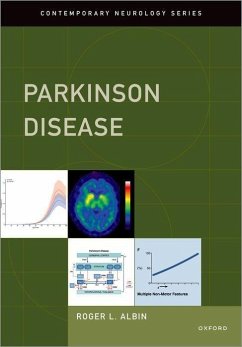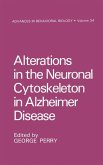Roger L. Albin (University of Michigan )
Parkinson Disease
Roger L. Albin (University of Michigan )
Parkinson Disease
- Gebundenes Buch
- Merkliste
- Auf die Merkliste
- Bewerten Bewerten
- Teilen
- Produkt teilen
- Produkterinnerung
- Produkterinnerung
Parkinson Disease is a comprehensive introduction to the biology and clinical features of Parkinson disease (PD). Topics covered include nosology of PD, PD epidemiology, pathology and pathophysiology of PD, and theories of PD pathogenesis. This book intends to be a useful overview, bridging the gap between general textbooks and specific topical reviews.
Andere Kunden interessierten sich auch für
![Alterations in the Neuronal Cytoskeleton in Alzheimer Disease Alterations in the Neuronal Cytoskeleton in Alzheimer Disease]() George PerryAlterations in the Neuronal Cytoskeleton in Alzheimer Disease83,99 €
George PerryAlterations in the Neuronal Cytoskeleton in Alzheimer Disease83,99 €![Environmental Factors in Neurodevelopmental and Neurodegenerative Disorders Environmental Factors in Neurodevelopmental and Neurodegenerative Disorders]() Environmental Factors in Neurodevelopmental and Neurodegenerative Disorders198,99 €
Environmental Factors in Neurodevelopmental and Neurodegenerative Disorders198,99 €![Navigating Life with Parkinson's Disease Navigating Life with Parkinson's Disease]() Parashos, Sotirios A., MD (Professor, Professor, Struthers ParkinsonNavigating Life with Parkinson's Disease19,99 €
Parashos, Sotirios A., MD (Professor, Professor, Struthers ParkinsonNavigating Life with Parkinson's Disease19,99 €![Neurodegeneratieve ziekten: Kuru, Alzheimer, Parkinson, Huntington Neurodegeneratieve ziekten: Kuru, Alzheimer, Parkinson, Huntington]() Jose O'DalyNeurodegeneratieve ziekten: Kuru, Alzheimer, Parkinson, Huntington47,99 €
Jose O'DalyNeurodegeneratieve ziekten: Kuru, Alzheimer, Parkinson, Huntington47,99 €![Machine Learning and Deep Learning in Natural Language Processing Machine Learning and Deep Learning in Natural Language Processing]() Anitha S. PillaiMachine Learning and Deep Learning in Natural Language Processing130,99 €
Anitha S. PillaiMachine Learning and Deep Learning in Natural Language Processing130,99 €![Moving along Moving along]() Lisbeth FrølundeMoving along46,95 €
Lisbeth FrølundeMoving along46,95 €![Michael Parkinson on Cricket Michael Parkinson on Cricket]() Michael ParkinsonMichael Parkinson on Cricket16,99 €
Michael ParkinsonMichael Parkinson on Cricket16,99 €-
-
-
Parkinson Disease is a comprehensive introduction to the biology and clinical features of Parkinson disease (PD). Topics covered include nosology of PD, PD epidemiology, pathology and pathophysiology of PD, and theories of PD pathogenesis. This book intends to be a useful overview, bridging the gap between general textbooks and specific topical reviews.
Hinweis: Dieser Artikel kann nur an eine deutsche Lieferadresse ausgeliefert werden.
Hinweis: Dieser Artikel kann nur an eine deutsche Lieferadresse ausgeliefert werden.
Produktdetails
- Produktdetails
- CONTEMPORARY NEUROLOGY SERIES
- Verlag: Oxford University Press Inc
- Seitenzahl: 304
- Erscheinungstermin: 25. August 2022
- Englisch
- Abmessung: 259mm x 184mm x 24mm
- Gewicht: 838g
- ISBN-13: 9780190843014
- ISBN-10: 0190843012
- Artikelnr.: 65340042
- Herstellerkennzeichnung
- Libri GmbH
- Europaallee 1
- 36244 Bad Hersfeld
- gpsr@libri.de
- CONTEMPORARY NEUROLOGY SERIES
- Verlag: Oxford University Press Inc
- Seitenzahl: 304
- Erscheinungstermin: 25. August 2022
- Englisch
- Abmessung: 259mm x 184mm x 24mm
- Gewicht: 838g
- ISBN-13: 9780190843014
- ISBN-10: 0190843012
- Artikelnr.: 65340042
- Herstellerkennzeichnung
- Libri GmbH
- Europaallee 1
- 36244 Bad Hersfeld
- gpsr@libri.de
Roger L. Albin, M.D. is a graduate of Oberlin College and the University of Pittsburgh School of Medicine. He received clinical and post-doctoral training at the University of Michigan, where his mentors were Anne Young and the late Jack Penney. His primary research interest is the pathophysiology of basal ganglia disorders, including Parkinson disease, Tourette syndrome, and Huntington disease. He is presently Co-Director of the Parkinson Disease & Movement Disorders Division and Director of the Udall Center at the University of Michigan, and Associate Director for Research at the VAAAHS GRECC.
* Chapter 1: Definition, History, Nosology, and Classification
* Introduction and Definition
* Brief History of PD
* Nosology and Classification Scheme
* Classification Level 1
* Classification Level 2
* Ambiguities and Future Directions
* Conclusion
* Chapter 2: Epidemiology
* Introduction
* Prevalence
* Incidence
* Mortality
* Risk Factors
* Implications for Understanding Etiopathogenesis and the Future Burden
of PD
* Chapter 3: Pathology
* Introduction
* The Aging Brain
* Gross Pathology, Lewy Pathology, and a-Synucleinopathy
* Substantia Nigra Pars Compacta Pathology
* Idiopathic Lewy Body Disease (iLBD)
* The Braak et al. Staging System
* Synucleinopathy Outside the Brain
* Non-Synuclein Pathologies
* Chapter 4: Pathophysiology I - Basal Ganglia Architecture and the
Standard Model
* Introduction
* Basic Basal Ganglia Architecture
* The "Standard" Model of Basal Ganglia Pathophysiology
* Complexities of Basal Ganglia Architecture
* Conclusion
* Chapter 5: Pathophysiology II - Neurotransmitter System Dysfunctions
* Introduction
* Nigrostriatal Dopamine Signaling Functions
* Habit Formation and Chunking
* Cholinergic Projection System Dysfunctions
* Serotoninergic System Dysfunctions
* Conclusions and Future Challenges
* Chapter 6: Genetics of Parkinson Disease
* Introduction
* Dominant Forms of PD
* Recessive Forms of PD
* GBA
* PD Genetic Risk Factors
* Implications of PD Genetic Research
* Chapter 7: Pathogenesis
* Neuronal Vulnerability
* Alpha-Synuclein
* The Prion-Like Hypothesis
* Mitochondrial Dysfunction
* Oxidative Stress
* Endolysosomal Dysfunction
* Neuroinflammation
* Neuroprotection Trials
* Conclusions
* Chapter 8: Prodromal Parkinson Disease
* Introduction
* REM Sleep Behavior Disorder
* Observational Studies
* REM Sleep Behavior Disorder Cohort Studies
* Genetic Cohort Studies
* Autonomic Failure
* Future Directions
* Chapter 9: Clinical Features I - Initial Evaluation
* Presentation Features
* Nature of Diagnosis and Diagnostic Criteria
* History and Examination
* Differential Diagnosis
* Treatment Responsiveness
* Diagnostic Accuracy
* Chapter 10: Clinical Features II - Non-Motor Features
* Introduction
* Cognitive Impairments
* Neuropsychiatric Disorders
* Sleep Disorders
* Pain
* Fatigue
* Autonomic Disorders
* Visual Disorders
* Oral Health
* Conclusion
* Chapter 11: Clinical Features III - Natural History
* Introduction
* Assessing PD Progression
* PD Progression - Clinically Salient Features
* Subgroups
* Natural History Summary
* Continuing Care
* End of Life Care
* Chapter 12: Pharmacology I - L-Dopa Pharmacokinetics and
Pharmacodynamics
* Introduction
* Dopaminergic Neurotransmission
* L-Dopa Pharmacokinetics
* L-Dopa Pharmacodynamics
* Peak Dose Dyskinesias
* Interactions of L-Dopa Pharmacokinetics, Pharmacodynamics, and
Disease Progression Summary and Future Directions
* Chapter 13: Pharmacology II - Treating Parkinson Disease
* Introduction
* Using L-Dopa
* When the Honeymoon Is Over
* L-Dopa Adjuncts
* Dopamine Agonists
* Cholinergic Agents
* Other Symptomatic Therapies
* Future Directions
* Chapter 14: Surgery
* Introduction
* Deep Brain Stimulation: Rationale and Possible Mechanisms
* Deep Brain Stimulation: Procedures
* Deep Brain Stimulation: STN DBS Benefits
* Deep Brain Stimulation: GPi DBS Benefits and STN vs GPi DBS
* Deep Brain Stimulation: Adverse Events
* Lesional Procedures
* Cell-Based and Gene Therapies
* Future Directions
* Coda: Looking Ahead
* Introduction and Definition
* Brief History of PD
* Nosology and Classification Scheme
* Classification Level 1
* Classification Level 2
* Ambiguities and Future Directions
* Conclusion
* Chapter 2: Epidemiology
* Introduction
* Prevalence
* Incidence
* Mortality
* Risk Factors
* Implications for Understanding Etiopathogenesis and the Future Burden
of PD
* Chapter 3: Pathology
* Introduction
* The Aging Brain
* Gross Pathology, Lewy Pathology, and a-Synucleinopathy
* Substantia Nigra Pars Compacta Pathology
* Idiopathic Lewy Body Disease (iLBD)
* The Braak et al. Staging System
* Synucleinopathy Outside the Brain
* Non-Synuclein Pathologies
* Chapter 4: Pathophysiology I - Basal Ganglia Architecture and the
Standard Model
* Introduction
* Basic Basal Ganglia Architecture
* The "Standard" Model of Basal Ganglia Pathophysiology
* Complexities of Basal Ganglia Architecture
* Conclusion
* Chapter 5: Pathophysiology II - Neurotransmitter System Dysfunctions
* Introduction
* Nigrostriatal Dopamine Signaling Functions
* Habit Formation and Chunking
* Cholinergic Projection System Dysfunctions
* Serotoninergic System Dysfunctions
* Conclusions and Future Challenges
* Chapter 6: Genetics of Parkinson Disease
* Introduction
* Dominant Forms of PD
* Recessive Forms of PD
* GBA
* PD Genetic Risk Factors
* Implications of PD Genetic Research
* Chapter 7: Pathogenesis
* Neuronal Vulnerability
* Alpha-Synuclein
* The Prion-Like Hypothesis
* Mitochondrial Dysfunction
* Oxidative Stress
* Endolysosomal Dysfunction
* Neuroinflammation
* Neuroprotection Trials
* Conclusions
* Chapter 8: Prodromal Parkinson Disease
* Introduction
* REM Sleep Behavior Disorder
* Observational Studies
* REM Sleep Behavior Disorder Cohort Studies
* Genetic Cohort Studies
* Autonomic Failure
* Future Directions
* Chapter 9: Clinical Features I - Initial Evaluation
* Presentation Features
* Nature of Diagnosis and Diagnostic Criteria
* History and Examination
* Differential Diagnosis
* Treatment Responsiveness
* Diagnostic Accuracy
* Chapter 10: Clinical Features II - Non-Motor Features
* Introduction
* Cognitive Impairments
* Neuropsychiatric Disorders
* Sleep Disorders
* Pain
* Fatigue
* Autonomic Disorders
* Visual Disorders
* Oral Health
* Conclusion
* Chapter 11: Clinical Features III - Natural History
* Introduction
* Assessing PD Progression
* PD Progression - Clinically Salient Features
* Subgroups
* Natural History Summary
* Continuing Care
* End of Life Care
* Chapter 12: Pharmacology I - L-Dopa Pharmacokinetics and
Pharmacodynamics
* Introduction
* Dopaminergic Neurotransmission
* L-Dopa Pharmacokinetics
* L-Dopa Pharmacodynamics
* Peak Dose Dyskinesias
* Interactions of L-Dopa Pharmacokinetics, Pharmacodynamics, and
Disease Progression Summary and Future Directions
* Chapter 13: Pharmacology II - Treating Parkinson Disease
* Introduction
* Using L-Dopa
* When the Honeymoon Is Over
* L-Dopa Adjuncts
* Dopamine Agonists
* Cholinergic Agents
* Other Symptomatic Therapies
* Future Directions
* Chapter 14: Surgery
* Introduction
* Deep Brain Stimulation: Rationale and Possible Mechanisms
* Deep Brain Stimulation: Procedures
* Deep Brain Stimulation: STN DBS Benefits
* Deep Brain Stimulation: GPi DBS Benefits and STN vs GPi DBS
* Deep Brain Stimulation: Adverse Events
* Lesional Procedures
* Cell-Based and Gene Therapies
* Future Directions
* Coda: Looking Ahead
* Chapter 1: Definition, History, Nosology, and Classification
* Introduction and Definition
* Brief History of PD
* Nosology and Classification Scheme
* Classification Level 1
* Classification Level 2
* Ambiguities and Future Directions
* Conclusion
* Chapter 2: Epidemiology
* Introduction
* Prevalence
* Incidence
* Mortality
* Risk Factors
* Implications for Understanding Etiopathogenesis and the Future Burden
of PD
* Chapter 3: Pathology
* Introduction
* The Aging Brain
* Gross Pathology, Lewy Pathology, and a-Synucleinopathy
* Substantia Nigra Pars Compacta Pathology
* Idiopathic Lewy Body Disease (iLBD)
* The Braak et al. Staging System
* Synucleinopathy Outside the Brain
* Non-Synuclein Pathologies
* Chapter 4: Pathophysiology I - Basal Ganglia Architecture and the
Standard Model
* Introduction
* Basic Basal Ganglia Architecture
* The "Standard" Model of Basal Ganglia Pathophysiology
* Complexities of Basal Ganglia Architecture
* Conclusion
* Chapter 5: Pathophysiology II - Neurotransmitter System Dysfunctions
* Introduction
* Nigrostriatal Dopamine Signaling Functions
* Habit Formation and Chunking
* Cholinergic Projection System Dysfunctions
* Serotoninergic System Dysfunctions
* Conclusions and Future Challenges
* Chapter 6: Genetics of Parkinson Disease
* Introduction
* Dominant Forms of PD
* Recessive Forms of PD
* GBA
* PD Genetic Risk Factors
* Implications of PD Genetic Research
* Chapter 7: Pathogenesis
* Neuronal Vulnerability
* Alpha-Synuclein
* The Prion-Like Hypothesis
* Mitochondrial Dysfunction
* Oxidative Stress
* Endolysosomal Dysfunction
* Neuroinflammation
* Neuroprotection Trials
* Conclusions
* Chapter 8: Prodromal Parkinson Disease
* Introduction
* REM Sleep Behavior Disorder
* Observational Studies
* REM Sleep Behavior Disorder Cohort Studies
* Genetic Cohort Studies
* Autonomic Failure
* Future Directions
* Chapter 9: Clinical Features I - Initial Evaluation
* Presentation Features
* Nature of Diagnosis and Diagnostic Criteria
* History and Examination
* Differential Diagnosis
* Treatment Responsiveness
* Diagnostic Accuracy
* Chapter 10: Clinical Features II - Non-Motor Features
* Introduction
* Cognitive Impairments
* Neuropsychiatric Disorders
* Sleep Disorders
* Pain
* Fatigue
* Autonomic Disorders
* Visual Disorders
* Oral Health
* Conclusion
* Chapter 11: Clinical Features III - Natural History
* Introduction
* Assessing PD Progression
* PD Progression - Clinically Salient Features
* Subgroups
* Natural History Summary
* Continuing Care
* End of Life Care
* Chapter 12: Pharmacology I - L-Dopa Pharmacokinetics and
Pharmacodynamics
* Introduction
* Dopaminergic Neurotransmission
* L-Dopa Pharmacokinetics
* L-Dopa Pharmacodynamics
* Peak Dose Dyskinesias
* Interactions of L-Dopa Pharmacokinetics, Pharmacodynamics, and
Disease Progression Summary and Future Directions
* Chapter 13: Pharmacology II - Treating Parkinson Disease
* Introduction
* Using L-Dopa
* When the Honeymoon Is Over
* L-Dopa Adjuncts
* Dopamine Agonists
* Cholinergic Agents
* Other Symptomatic Therapies
* Future Directions
* Chapter 14: Surgery
* Introduction
* Deep Brain Stimulation: Rationale and Possible Mechanisms
* Deep Brain Stimulation: Procedures
* Deep Brain Stimulation: STN DBS Benefits
* Deep Brain Stimulation: GPi DBS Benefits and STN vs GPi DBS
* Deep Brain Stimulation: Adverse Events
* Lesional Procedures
* Cell-Based and Gene Therapies
* Future Directions
* Coda: Looking Ahead
* Introduction and Definition
* Brief History of PD
* Nosology and Classification Scheme
* Classification Level 1
* Classification Level 2
* Ambiguities and Future Directions
* Conclusion
* Chapter 2: Epidemiology
* Introduction
* Prevalence
* Incidence
* Mortality
* Risk Factors
* Implications for Understanding Etiopathogenesis and the Future Burden
of PD
* Chapter 3: Pathology
* Introduction
* The Aging Brain
* Gross Pathology, Lewy Pathology, and a-Synucleinopathy
* Substantia Nigra Pars Compacta Pathology
* Idiopathic Lewy Body Disease (iLBD)
* The Braak et al. Staging System
* Synucleinopathy Outside the Brain
* Non-Synuclein Pathologies
* Chapter 4: Pathophysiology I - Basal Ganglia Architecture and the
Standard Model
* Introduction
* Basic Basal Ganglia Architecture
* The "Standard" Model of Basal Ganglia Pathophysiology
* Complexities of Basal Ganglia Architecture
* Conclusion
* Chapter 5: Pathophysiology II - Neurotransmitter System Dysfunctions
* Introduction
* Nigrostriatal Dopamine Signaling Functions
* Habit Formation and Chunking
* Cholinergic Projection System Dysfunctions
* Serotoninergic System Dysfunctions
* Conclusions and Future Challenges
* Chapter 6: Genetics of Parkinson Disease
* Introduction
* Dominant Forms of PD
* Recessive Forms of PD
* GBA
* PD Genetic Risk Factors
* Implications of PD Genetic Research
* Chapter 7: Pathogenesis
* Neuronal Vulnerability
* Alpha-Synuclein
* The Prion-Like Hypothesis
* Mitochondrial Dysfunction
* Oxidative Stress
* Endolysosomal Dysfunction
* Neuroinflammation
* Neuroprotection Trials
* Conclusions
* Chapter 8: Prodromal Parkinson Disease
* Introduction
* REM Sleep Behavior Disorder
* Observational Studies
* REM Sleep Behavior Disorder Cohort Studies
* Genetic Cohort Studies
* Autonomic Failure
* Future Directions
* Chapter 9: Clinical Features I - Initial Evaluation
* Presentation Features
* Nature of Diagnosis and Diagnostic Criteria
* History and Examination
* Differential Diagnosis
* Treatment Responsiveness
* Diagnostic Accuracy
* Chapter 10: Clinical Features II - Non-Motor Features
* Introduction
* Cognitive Impairments
* Neuropsychiatric Disorders
* Sleep Disorders
* Pain
* Fatigue
* Autonomic Disorders
* Visual Disorders
* Oral Health
* Conclusion
* Chapter 11: Clinical Features III - Natural History
* Introduction
* Assessing PD Progression
* PD Progression - Clinically Salient Features
* Subgroups
* Natural History Summary
* Continuing Care
* End of Life Care
* Chapter 12: Pharmacology I - L-Dopa Pharmacokinetics and
Pharmacodynamics
* Introduction
* Dopaminergic Neurotransmission
* L-Dopa Pharmacokinetics
* L-Dopa Pharmacodynamics
* Peak Dose Dyskinesias
* Interactions of L-Dopa Pharmacokinetics, Pharmacodynamics, and
Disease Progression Summary and Future Directions
* Chapter 13: Pharmacology II - Treating Parkinson Disease
* Introduction
* Using L-Dopa
* When the Honeymoon Is Over
* L-Dopa Adjuncts
* Dopamine Agonists
* Cholinergic Agents
* Other Symptomatic Therapies
* Future Directions
* Chapter 14: Surgery
* Introduction
* Deep Brain Stimulation: Rationale and Possible Mechanisms
* Deep Brain Stimulation: Procedures
* Deep Brain Stimulation: STN DBS Benefits
* Deep Brain Stimulation: GPi DBS Benefits and STN vs GPi DBS
* Deep Brain Stimulation: Adverse Events
* Lesional Procedures
* Cell-Based and Gene Therapies
* Future Directions
* Coda: Looking Ahead








